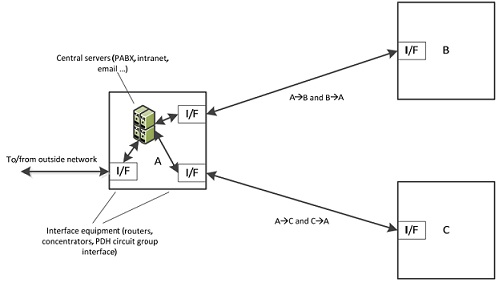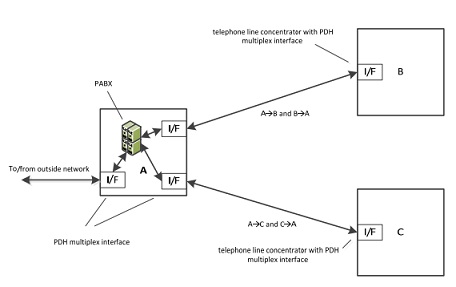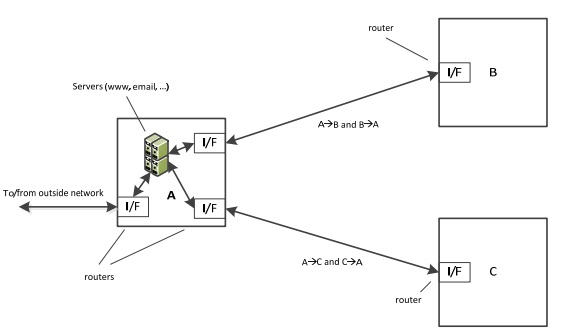Reference no: EM13864927
1. The general scenario
Consider a large organisation with 3 large office buildings A, B, C. Building A is the building where all central IT facilities of the organisation (PABX, VoIP server, Intranet server) are located. Buildings are connected with each other and with the outside world as shown in the figure below.

The central servers include, depending on the scenario, PABX, Intranet www and file servers, mail server etc.
The I/F denotes interface equipment to the connecting link or circuit group. Depending on the scenario, it might be a PDH multiplex interface, IP router, etc.
Common assumptions:
1. There are 2000 employees working in building A, 1500 in building B and 1000 in building C.
2. Assume that all telephone and data traffic generated by the employees can be considered Poisson. This is a crude assumption (please check the slides on Internet traffic), but necessary for simplicity.
3. Also for simplicity, assume that all employees generate the same quantities of telephone and data traffic, to/from the same proportions of internal and external destinations/origins. The traffic is distributed uniformly among employees, i.e. employee X sends/receives the same amount of traffic to/from employee Y as it does to/from another employee Z.
2. Your tasks
Task 1:
Make realistic assumptions as to the intensity of traffic per individual employee. In other words, assign numbers to the following:
a) Average arrival rate of telephone calls to/from each employee's telephone λi (assume that this includes both outgoing and incoming calls)
b) Average call holding time (assume the same figure for all calls)
c) Proportion of internal telephone traffic per employee i.e. traffic exchanged with other employees of the organisation (this will be uniformly distributed across all other employees), αint.Note that the proportion of telephone traffic exchanged with the outside world will be equal to 1 - αint.
d) The average downlink data traffic (file and email downloads, web pages) per employee in bps (or kbps or Mbps - whatever suits the purpose).
e) Proportion of downlink data traffic originating at organisation's internal servers (note: the remaining downlink data traffic will originate at external sources).
f) The average uplink data traffic (web, email etc. requests, TCP ACKs, uploads of emails) per employee in bps
g) Proportion of uplink data traffic going to internal servers (the remaining part will go to the outside world). Provide rationale for each assumption (i.e. explain why you consider it realistic).
Task 2:
For this task, only consider telephone traffic. Assume that all telephone traffic is circuitswitched as in the traditional PSTN. The relevant scenario is illustrated in the figure below. The "central servers" become a PABX, the "interface equipment" at B and C become telephone line concentrators with PDH multiplex equipment, and the interface at A becomes PDH multiplex equipment, as in the figure.

a) Given the assumptions made in Task 1 a,b,c, map the total traffic flows (in Erlangs) onto all circuit groups: A-B, A-C and external circuit group. Show the reasoning leading to the answer you gave. Take care here - make sure that you get this right given the uniform distribution of traffic from each employee across all other employees and the numbers of employees in each building.
b) If we require that the end-to-end GoS probability of loss for each call is no greater than 0.01, what are the GoS probabilities of loss allowed for each of the three groups of circuits?
c) Given the results in a and b above, what are the required numbers of circuits in each group?
Task 3:
For this task, only consider data traffic as specified in Task 1 d,e,f,g. As illustrated in the figure below, the "central servers" now become the email/www/proxy servers, and the "interface equipment" is simply IP routers.
a) Map the total flows of data (in kbps or Mbps) onto all three links connecting buildings B and C with A and bulding A with outside world. Please assume that all links are part of WAN (leased from external providers), not part of the organisation's Ethernet. As a consequence, for each link you have to state separately the downlink and uplink traffic. Provide rationale (explanation) for your answer.
b) Given the traffic flows obtained in a above, state the data rate capacity (in Mbps) required for each link (separately in the downlink and uplink directions), under the condition that link access delay for each link cannot exceed 5 ms. Assume that the internal data transfers between servers, hosts and routers located in the same building incur negligible delay, and that the processing delay at servers and routers is also negligible. Note: you may need to make a realistic assumption regarding the average packet length (why? - consult the slides on Little's theorem and packet delay or material on queuing delay covered in Computer Communications and Networks).

Task 4:
For this task, assume that all telephony needs of the organisation are served with the VoIP solution. Assume that the VoIP codec rate is 64 kbps. Assume that the modem transmits data only when there is a talkspurt, and that it does not transmit anything during the silence period. Assume the average talkspurt duration of 0.6 s and the average silence duration of 0.4 s, and that in a typical phone call 50% of talkspurts are transmitted in one direction, and 50% in the other (i.e. that either one or the other party in the call can talk and that they talk, on average, for the same amount of time). This results in the symmetry of downlink and uplink traffic loads during the VoIP call.
a) Calculate the additional VoIP data traffic (in kbps or Mbps) loading each of the three links (external, A-B, A-C) in each (uplink and downlink) direction. Note: to find out the average data traffic generated by a VoIP call in each direction, you may reuse the calculation of data source as given in the tutorial materials, but in the case at hand there are much simpler ways to get the same result.
b) Given that all traffic in the organisation is now data traffic, calculate the total data traffic for each link in each direction (i.e. add the VoIP traffic to the data traffic resulting from Task 3a).
c) Calculate the data rates for each link (in each direction) required to service the total traffic from b above, under the same assumption of no more than 5ms link access delay on each link. Note: see the comment to Task 3b.